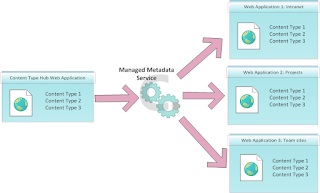As we all know SharePoint is a web-based, collaborative platform that integrates with Microsoft Office. Launched in 2001, SharePoint is primarily sold as a document management and storage system, but the product is highly configurable and usage varies substantially between organizations.
What is Content Type Hub (CTH)?

Content Type Hub is a centralized location where we manage and publish content types to other web applications.
- Content Type Hub is actually a Site Collection.
- Content Type is published and subscribed using the Managed Metadata Service application.
According to Microsoft, A content type is a reusable collection of metadata (columns), workflow, behavior, and other settings for a category of items or documents in a Microsoft SharePoint Foundation 2010 list or document library. Content types enable you to manage the settings for a category of information in a centralized, reusable way.
For example, imagine a business situation in which you have three different types of documents: expense reports, purchase orders, and invoices. All three types of documents have some characteristics in common; for one thing, they are all financial documents and contain data with values in currency. Yet each type of document has its own data requirements, its own document template, and its own workflow. One solution to this business problem is to create four content types. The first content type, Financial Document, could encapsulate data requirements that are common to all financial documents in the organization. The remaining three, Expense Report, Purchase Order, and Invoice, could inherit common elements from Financial Document. In addition, they could define characteristics that are unique to each type, such as a particular set of metadata, a document template to be used in creating a new item, and a specific workflow for processing an item.
Content type includes
- The metadata, or properties, you want to assign to this type. These are represented by site columns added to the list or document library when you add the content type. For more information, see Columns.
- Custom New, Edit, and Display forms to use with this content type. For more information, see Custom Information in Content Types.
- Workflows available for items of this content type. These can be defined to start automatically based on a selected event or condition, or through user selection. For more information, see the Workflow Associations property.
- For document content types, the document template on which to base documents of this type. For more information, see Document Template Element (Content Type).
- Any information necessary for custom solutions that are associated with this content type. You can store this information in the content type as one or more XML documents. For more information, see Custom Information in Content Types.
Content Type Syndication
It is new feature that is part of the Managed Metadata service in SharePoint 2010. It solves a long-standing problem from SharePoint 2007, which is how do I create an enterprise library of content types and synchronize them amongst many different site collections. We often had to design and build solutions to work around this issue in SharePoint 2007, but now we have something that we can use out of the box.
In moss 2007, you have a Site Collection in Web Application1 and you have created a series of content types to use. Now, you create Web Application2 and find the necessity to reuse the content types created in Web Application 1. There is no way you could share or reference those content types created in Web Application1 in Web Application2. The only way possible is to create or write an application which would install those content types. This situation is pretty common in large organizations. This can be even considered for exposing base content types you use across multiple web applications in the farm.
Steps to create Content Type
- Create a new content type under the site collection. Name it Travel Request.
- Open Central Administration then select Manage Service Application > Choose Managed Metadata Service > Click Properties.

- Enter a Content Type Hub URL.
- Now choose the connection (sub item) of Managed Metadata Service.
- Check the following options that ensure subscribing published content types.

- Back to our Source Content Type. Choose the Content Type Settings > Manage Publishing for this Content Type.
- Choose the Publish option and click the OK button.
- Go to Central Administration then select Monitoring > Review Job Definitions. Select the following jobs:
- Content Type Hub
- Content Type Subscriber (For Default SharePoint Site)
- Choose the Run Now option for each job as shown below inducing a few minutes delay in between.
- Refresh the Subscribing site collection and you should be able to see the new content type.
This concludes our content type publishing and subscribing.
Summary of Activities
The following is a summary of activities:- Create Content Type Hub: Web Application and Site Collection
- Create Content Type under Site Collection
- Manage Metadata Service Application
- Manage Metadata Service Application Connection
- Publish Content Type
- Run Timer Jobs
- Refresh Subscribing Site Collection
- Ensure Content Type is visible.
Content Type Hub[Watch Video]
SharePoint 2010 introduced a new feature called Content Type Hubs to solve it. Content Type Hub is a central location where you can manage and publish your content types – so now web applications can subscribe to this hub and pull down the published content types from the hub. Even receive updates on the published content types. Don’t you think it is of great value? Same feature continues to be in SharePoint 2013.
Provisioning a site to be Enterprise Metadata hub site for your Farm:
Given is the step by steps approach to provisioning a site for CTH [Read Steps].
Just follow the steps and you are done.



